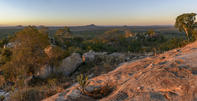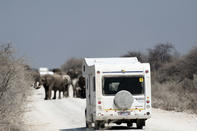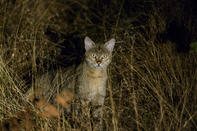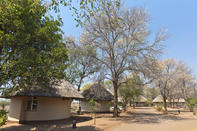An Asset to the Nation
When the Kruger National Park became a reality, there was much work to be done. One of the stipulations of the National Park Act was that the park must become an asset to the nation and members of the public should be allowed into the reserve to experience their wonderful natural heritage.

This meant that the park had to build roads, rest camps and all the other conveniences of contemporary tourism. However, there wasn’t any money for infrastructure development. Appeals to the public were made, which did not yield much of a response.
Eventually, government coughed up some cash (an annual contribution of £7000 from the Union Government and £3000 from the Transvaal (now, Mpumalanga, North West & Limpopo) provincial coffers, plus a once-off gift of £7000 from the Treasury, but that wasn’t enough for the vast public works that were required.
'Two-Track' Roads

Never one to shirk a challenge, James Steven Hamilton set about with the limited funds available. He began by improving the rough roads that linked up the various ranger stations in the park.
The first ‘two-track’ roads to be constructed included the route from Crocodile Bridge to Lower Sabie, from Acornhoek to the Mozambique border via Satara, from Gravellote to Makubas Kraal (near Letaba), and White River to Pretoriuskop.
These thoroughfares were built with the help of migrant labourers in conjunction with the rangers. Then, in 1927, it was decided that Pretoriuskop (the most accessible ranger station) would be opened for tourism.
Several loop roads around the Pretoriuskop area were built, and day permits were introduced. They then enlarged the path from Sabi Bridge to the Olifants River, followed by the road from Sabi Bridge down to Pretoriuskop and the Crocodile River.
Visitors Were Enchanted

Initially, visitors were expected to make their own camps and bring everything they needed along with them. Early tourists were even permitted to carry one loaded firearm in their car, in case of attack by a rogue lion. However, these guns were secured by a piece of wire and a lead seal so that the rangers could tell if they had been fired. Despite the rough roads, absence of facilities and relative remoteness of the reserve, visitors were enchanted by their new National Park.
Tourist numbers grew exponentially. In 1927, the first year of operations, three cars carrying a dozen intrepid visitors entered the park through Pretoriuskop. The following year, there were 180 cars. In 1929, the number of cars had surpassed 850. Soon, the Parks Board began charging an entrance fee of £1 per car and this finally set the Kruger Park on the road to financial sustainability.
Every year, during the dry season, James Steven Hamilton and the Park staff continued to build additional roads and the network grew rapidly; from 122 miles in 1927 to 900 in 1936. Ferries and pontoons were constructed to transport cars across the major rivers (such as the Sabi, Crocodile and Olifants).
Makeshift bridges of wooden poles anchored to the riverbed were built across the smaller streams. In the summer, these primitive roadways were often washed away by floods, and maintenance of the network was a constant chore. Once this construction process was underway, James Steven Hamilton turned his attention to the problem of where the tourists were going to sleep.
By all accounts, early accommodation in the Kruger Park was a chaotic affair. There were no rest camps or shops in the reserve and guests needed to be entirely self-sufficient.
A Good Little Business

The task of caring for the herds of tourists fell to the unfortunate rangers, who were forced to turn their humble field stations into guesthouses. As James Steven-Hamilton describes it, “The rangers were obliged to surrender their own quarters to the visitors, who camped out in every room and on the verandahs, the rightful owner having to sleep as best he could outside.” As one ranger remarked, “I did not mind so much their using my soap, towels, plates, knives and forks, but I do wish they had not used my toothbrush!” James Steven-Hamilton realised that the situation was untenable.
He simply could not have his rangers neglecting their wildlife duties in order to wrangle the unruly tourist hordes. Luckily, one of the members of the Parks Board was the manager of a Johannesburg gold mine and he donated surplus building material to the Park. Construction thus began on the first three tourist huts, located at Satara, Pretoriuskop and Sabi Bridge.
These simple ‘rondawels’ consisted of a circular concrete wall topped by a conical thatched roof and, by 1930, there were about 100 beds available located in Pretoriuskop, Lower Sabie, Balule, Olifants, Satara, Malelane, Letaba and Sabi Bridge. The latter had by this time been renamed Skukuza, after the Tsonga nickname for James Stevenson-Hamilton – he who sweeps clean.
To ensure the smooth running of the Park, the management of the new rest camps was gradually handed over to contractors and supervisory staff, who provided petrol, catering and supplies to the tourists. Entry permits were issued at the entrance gates by ‘tourist officers’, who collected entrance fees on behalf of the park in exchange for a small percentage of the take. It was becoming a good little business.
By David Fleminger During the 1890s, things grew chaotic in the Republic of the Transvaal (present day Mpumalanga). Since the discovery of gold, Johannesburg h...
During the 1890s, things grew chaotic in the Republic of the Transvaal (present day Mpumalanga). Since the discovery of gold, Johannesburg h...